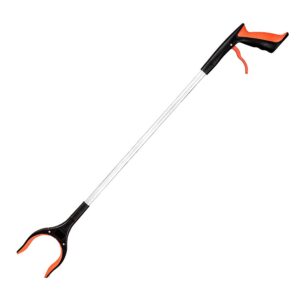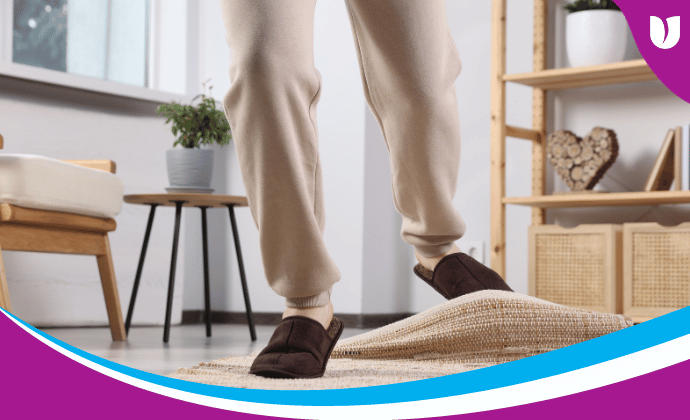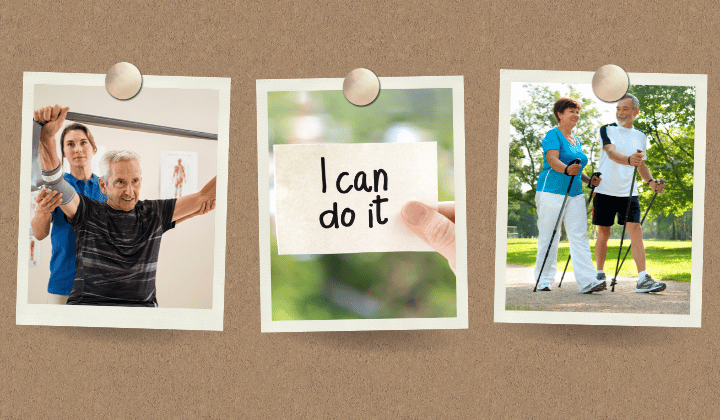At home there are many things you can do to ensure safety if you experience postural instability.
Entry
- Make sure the path or entrance to your front door is clear of trip hazards and well lit.
- Have handrails on both sides of all entry steps.
- Install a grab-bar or ramp if the front doorstep is difficult to negotiate
Kitchen
Loss of balance can easily happen due to the stretching, bending, lifting and carrying that happens in the kitchen.
- Don’t have things hanging. Put pans on the bench or leave them on the stove instead of hanging them or putting them into a cupboard.
- Store plates, bowls, cups and other regular items in a single, easily accessible drawer or shelf – not spread around the kitchen.
- Invest in a Reacher*. This inexpensive tool can help in picking things up from the floor and getting things of high shelves or wiping spills while seated or standing.
- Have a sturdy chair close by in the kitchen so you can sit to do a variety of tasks.
- Use slide-out shelving, a Lazy Susan or tea cart to help make things easier to reach and move around the kitchen.
- Keep the floor dry and clean. Ensure you have paper towels and a Reacher close by to clean up spills immediately.
Living/Lounge Room
Here are some minor adjustments can make your living room easier to navigate:
- Arrange the furniture around making moving around easier. Move anything that makes it difficult to get around. If you use a wheelchair or walker, you’ll need extra room around the furniture.
- Make it easier to get into or out of chairs or sofas by adding a pillow to help raise the height or buy some chair-risers to use under the chair legs to raise the height of the seat.
- Remove all mats and rugs to prevent tripping. If this isn’t possible, make sure there is a non-slip mat underneath and that the rug lies flat with no edges or corners sticking up. Tape them down if necessary.
- De-clutter and get rid of any trip hazards like electric cords and phone wires.
Bedroom
- If your bedroom is upstairs, ensure you hold onto the railing when going both up and down – or if possible, convert a downstairs room into your bedroom.
- Have a rail by the bed so you have something to hold onto when getting out of bed in case you become dizzy.
- Make sure what you want at night is close by (like water, pills and phone). Also ensure there is a clear path to the bathroom. Use a torch if turning on a light will wake others.
- Use a sturdy armchair to dress and undress to save hopping around and possibly losing your balance. A long-handled shoehorn can help with putting shoes on, saving you bending and losing balance on the way up. Keep your clothes within easy reach so you’re not reaching or bending to get them.
Bathroom
- Don’t rush to the bathroom. Go before you get desperate.
- Use low-pile, non-skid bathmats on wet and slippery floors. Non-slip rubber mats can be applied in the tub or shower to prevent slipping.
- Put a waterproof non-slip chair in the bathroom so you can sit whilst grooming yourself. These chairs can also be used in the shower.
- Keep shampoo, soap, etc within easy reach, on a shelf or ledge. Use a long-handled brush to clean feet, which save bending over and getting dizzy.
- A toilet seat riser and or safety rails are helpful when going to the toilet.
Bigger home modifications are expensive but sometimes necessary. Here are some ideas that may help.
- For a high curb or guttering, look into having it cut down.
- If the garage door sticks or is too heavy to lift, consider an automatic door.
- If outside stairs are a problem, cover them with a ramp or have a separate ramp installed.

*Reachers can be purchased at Kmart, Bunnings, mobility suppliers, and chemists.
References:
http://www.cec.health.nsw.gov.au/patient-safety-programs/adult-patient-safety/falls-prevention
https://www.medicalnewstoday.com/articles/balance-problems#when-to-see-a-doctor






